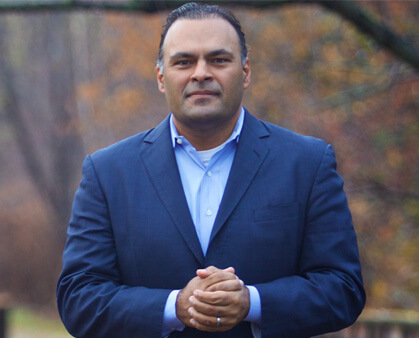An “Inside Look” at Precision Medicine, Cardiovascular & Kidney Disease: We Get It Straight from Bayer’s, Dr. Amit Sharma
By Elise Wilfinger
10.26.2021

Introduction
Chronic kidney disease (CKD) is highly correlative with cardiovascular risk, demonstrated in the form of coronary artery disease, heart failure, or sudden cardiac death. Cardiovascular events are higher in patients with early CKD compared with the general population, and more so with patients who are in its advanced stages.
Cardiovascular complications are actually the primary cause of death in this high-risk, CKD population.
All constituents, whether from the academic or commercial worlds, continue to seek understanding as to what drives kidney disease overall and what drives its progression. One goal is to unearth how precision medicine can better target therapeutic use to patient need.
Recently, I discussed this very topic with Dr. Amit Sharma, an accomplished, board-certified internist, nephrologist and hypertension specialist. Amit is the U.S. Vice President Cardiovascular & Renal, Medical Affairs at Bayer Pharmaceuticals, serves on the board of directors for ASN’s Kidney Health Initiative (a public private partnership with the FDA and Department of HHS) and holds various leadership positions with the National Kidney Foundation’s Patient Network and its National Leadership Council.
“It is hard to address complex medical problems – like diabetes, kidney disease and cardiovascular disease – when you only have 15 minutes or less.”
– Dr. Sharma
Elise:
Let’s set the stage. How do patient outcomes compare for cardiovascular vs kidney disease?
Amit:
Although improving, outcomes have not been as strong in kidney disease as they have been in some cancer or singular cardiovascular diseases, like coronary artery disease.
That’s primarily for three reasons:
- We haven’t had the right testing to give us insights into which patients will progress and who will need more assigned resources.
- The majority of patients with kidney disease – specifically, diabetic kidney disease – don’t know that they have it. When you are unaware of a condition, you can’t make meaningful changes toward a healthier life.
- Most physicians don’t have time to treat multiple medical problems. Doctors are expected to see a new patient within 30 minutes and follow-up patients within 15 minutes. It is hard to address complex medical problems – like diabetes, kidney disease and cardiovascular disease – when you only have 15 minutes or less.
“Today, a lot of our health care can be started with wearables and some basic lab work.”
– Dr. Sharma
Side note: Our readers may want to check out Eric Topol’s “The Patient Will See You Now. The Future of Medicine is in Your Hands,” for a more in-depth exploration of how mobile devices will (continue to) drive the medical revolution. Published in 2015, it was prescient of the growth in virtual health today. It detailed a perspective about how smartphones would play a role in healthcare one day: performing blood tests, medical scans, and filling in parts of the physical examination. Topol called this “bottom-up medicine,” where digitally empowered patients would take charge of their own health care.Elise:
Can virtual health and real-time analytics drive better outcomes?
Amit:
One thing that Covid-19 has taught us: virtual health can work. A patient doesn’t have to visit the doctor, go to the local hospital or even get a test done outside of the home. Individuals have more tools to stay on top of their own healthcare remotely, not just once a year, but every day.
A lot of our health care can be started with wearables and some basic lab work. Your Fitbit or Apple Watch can tell you how many more steps you need, when to stand up, how to get better sleep, and proper ways to breathe. It can even measure your ECG, your heart rhythm, and your blood oxygen level.
Imagine if we could capture even more real-world evidence or data points. How might that impact a “silent” killer like kidney disease?
The truth is, now we can capture more real-time data, further informing the interventions required; Advances in genotyping, phenotyping and biomarkers are leading the charge here.
For example, we continue to learn about the connection of patient genotype factors (inherited from one’s parents) and phenotype factors (a mix of genotype, environmental and epigenetic factors) with new kidney disease research. Further, we have a much better understanding of how to use diagnostics and therapeutics short- and long-term to predict those patients who are likelier to have an avoidable event.
Elise:
When will we realize the full potential of genotyping, phenotyping and how it impacts precision medicine implementation?
Amit:
Now that we’re mapping genetic code, we are better able to create and leverage precision medicine strategies and therapeutics for various pathways. That said, it will take years to scale this work to its full potential.
“I knew that protein or albumin in the urine were bad markers for kidney disease twenty-five years ago.”
– Dr. Sharma
Elise:
Wearing your pharma hat, how are biomarkers and electronic health record data also informing care, development of new therapeutics and/or usage of existing therapeutics?
Amit:
I knew that protein or albumin in the urine were bad markers for kidney disease twenty-five years ago. And yet, they are still being used as standard of care measurements today.
That said, most primary doctors are not even conducting these tests, largely because the disease is asymptomatic in its earliest stages.
Now, we have biomarkers and clinical features, that when combined with iterative machine learning, enable risk prediction formulas that give doctors the key answers needed: who is at highest risk vs not and what is the appropriate course of treatment.
This is critical, since we only have approximately 15 minutes with each patient. We need to be able to quickly review data and make an informed action plan. This risk prediction “score” will enable us to focus more resources on those who need it most and enable us to prescribe the best therapeutic.
Elise:
Therapeutics for the treatment of kidney disease seem to be coming into their own. Do some of these medications also have implications for cardiovascular disease?
Amit:
Yes, there is real cross-incidence of kidney and heart disease. I still reference Dr. Alan Go and Glen Chertow’s 2004 paper, Chronic kidney disease and the risks of death, cardiovascular events, and hospitalization, where they proved that with reduced estimated GFR or kidney function, there was a 2-15x rate increase in sudden death, cardiovascular events, and hospitalization in a large, community-based population (1.1 million).
With the new SGLT2 therapeutics, we can better optimize kidney care, and will thereby, also mitigate cardiovascular events.
Elise:
Have these new technologies and therapeutics driven better patient compliance?
Amit:
Yes, I think that they have. I also believe we have a long way to go.
Here’s one example: let’s say that you have a patient with decompensated heart failure, and they’ve been prescribed four medications to improve both their chances for survival and their quality of life. That patient starts on those medications, but like many others, may veer off course a few months later.
However, if that patient is presented with quantifiable data detailing his risk profile upstream – indicating that there is a 95% chance of him dying from a heart attack in ten years – he would likely be more compliant. We need broader awareness and access for these predictive tests and therapeutics that will drive this kind of change.
Elise:
Bringing our discussion to a close, what should be the market’s most important area of focus?
Amit:
In my opinion, the most important work right now is to ensure that we never lose sight of what the patient wants. Often, we find that what’s important to industry, is not what’s important to patients.
So, how can our work reflect their needs?
The Kidney Health Initiative does a great job here. One third of its Board of Directors is filled with actual kidney patients. When committees are formed, when protocols are developed, when recommendations are made – the patient perspective is always front and center.
Collaboration is also key. All of the advocacy organizations are finally working together, aligned to one goal: to prevent kidney disease vs treating patients on dialysis.
If you enjoyed this post, we’d be grateful if you would help us spread its content.

